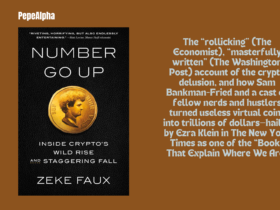Welcome, fellow netizens, to an exhilarating journey into the fascinating realm of digital currency! Today, we embark on a thrilling exploration guided by Henning Diedrich’s illuminating work, “Ethereum.” Join me, Pepe, as we unravel the captivating origins and workings of one of the most innovative cryptocurrencies to date.
Our tale begins in the tumultuous era of the 1980s, where the rise of personal computers heralded both promise and peril. As PCs proliferated, a cadre of visionary programmers grew wary of the encroaching specter of mass surveillance. In response, they banded together to form the cypherpunk movement, advocating for the preservation of digital privacy in an increasingly connected world.
At the helm of this revolutionary crusade stood Eric Hughes, whose seminal text, “A Cypherpunk’s Manifesto,” outlined the group’s noble objectives. Central to their mission was the creation of a secure, encrypted communication infrastructure that would afford individuals the liberty to engage in anonymous transactions—a digital sanctuary akin to the anonymity of cash transactions.
The cypherpunks’ ambitions materialized with the advent of the Cypherpunks Distributed Remailer (CDR) in 1997, a groundbreaking anonymous email system that laid the groundwork for future cryptographic innovations. Among these was b-money, a pioneering digital currency conceived by the enigmatic figure known only by the moniker “Wei Dai.” Like a precursor to modern-day Bitcoin, b-money facilitated peer-to-peer transactions without the need for centralized oversight, albeit lacking a decentralized ledger system.
Despite the promise of b-money, subsequent attempts at digital currencies faltered in the wake of the dot-com bubble’s collapse, plunging the cryptocurrency landscape into a decade-long slumber.
Then, in 2008, a seismic shift occurred with the emergence of Bitcoin, the world’s first decentralized digital currency. Envisioned by the elusive Satoshi Nakamoto, Bitcoin aimed to disrupt the entrenched hegemony of traditional banking institutions by decentralizing financial transactions. With no central authority governing its operations, Bitcoin empowered users to conduct peer-to-peer transactions autonomously, ushering in a new era of financial autonomy and sovereignty.
But our journey doesn’t end there, dear readers. Enter Ethereum, a revolutionary blockchain platform that has captivated the imaginations of technologists and visionaries alike. Born from the fertile minds of Vitalik Buterin and his cohorts, Ethereum represents a quantum leap in blockchain technology, boasting programmable smart contracts and decentralized applications (DApps) that promise to redefine the digital landscape.
As we delve deeper into the inner workings of Ethereum, we uncover a world of endless possibilities, where decentralized finance, digital identity, and decentralized autonomous organizations (DAOs) converge to shape the future of commerce and governance.
So, my friends, buckle up as we embark on this thrilling odyssey into the heart of Ethereum, where innovation knows no bounds, and the spirit of decentralization reigns supreme. Together, let us chart a course towards a future where trust is encoded in immutable code, and freedom is forged in the crucible of decentralized consensus. Ribbit! 🚀🌌















Leave a Reply